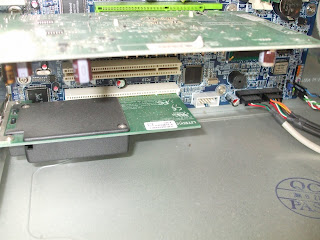The network settings are now set to home.








The fan and heat sink were removed,









Then View computer details and I then clicked on device manager and found the following details.




The display adapter - Mobile Intel(R) 965 Express chipset Family - manufacuter Intel Corporation

Today I made a category 5 unshielded Twisted Pair (UTP) Ethernet crossover cable. This was then tested for continuity and correct pin-outs, and correct wire on the right pin.
I cut the cable to the required length and cut back the plastic jacket from the wire and pulled the plastic cover back down the length of the wire.
The internal wires were laid in the following order from left to right;
· White/orange
· Orange
· White/Green
· Blue
· White/Blue
· Green
· White/Brown
· Brown
Then they were straightened out, flattened the internal wires and the wires were trimmed to be level.
I held the RJ-45 plug with the copper connections facing me and gently slipped the wires into the plug and towards the connectors.
I then crimped the wires firmly in place.
I then fitted a plug to the other end of the cable.
It is important to test the cable on completion. I plugged both ends of the cable into the unit and switched it on to proceed with the test.
There were two separate bars of indicators on the test unit, each with 8 lights. The indicator lights switch on as the test sequence is completed, wire-by-wire. If both the “input” and “output” indicators for each wire are brightly lit this indicates optimum connection. A dim light indicates poor connection and no light no connection. The lights should light in pairs indicating correct wiring.
http://cableorganizer.com/learning-center/how-to/how-to-test-RJ45-connection.htm
Unfortunately, as the test preceded lights 4 and 5 showed out of order meaning that the plugs failed the test. Two of the wires in one of the plugs were in the incorrect sequence and one plug failed the test.